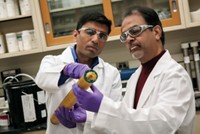Advertisement
Grab your lab coat. Let's get started
Welcome!
Welcome!
Create an account below to get 6 C&EN articles per month, receive newsletters and more - all free.
It seems this is your first time logging in online. Please enter the following information to continue.
As an ACS member you automatically get access to this site. All we need is few more details to create your reading experience.
Not you? Sign in with a different account.
Not you? Sign in with a different account.
ERROR 1
ERROR 1
ERROR 2
ERROR 2
ERROR 2
ERROR 2
ERROR 2
Password and Confirm password must match.
If you have an ACS member number, please enter it here so we can link this account to your membership. (optional)
ERROR 2
ACS values your privacy. By submitting your information, you are gaining access to C&EN and subscribing to our weekly newsletter. We use the information you provide to make your reading experience better, and we will never sell your data to third party members.
Business
The Right Mix: Small Companies Are Recruiting Skilled Scientists Willing To Wear Many Hats
by Susan J. Ainsworth
August 20, 2012
| A version of this story appeared in
Volume 90, Issue 34
Amid lingering economic uncertainty, some slivers of job opportunity are opening up for chemists within small companies along the East Coast. However, competition remains fierce.
In a job market crowded by recent graduates as well as the many scientists who have been laid off, employers have the luxury of being extremely choosy. When they evaluate potential new hires, fledgling firms look for those who not only possess cream-of-the-crop technical skills but are also willing to roll up their sleeves and do whatever is needed to help the company succeed.
To fill a single position for a medicinal chemist, “we might sift through about 100 résumés to find 10 candidates who are very well qualified,” says William C. Shakespeare, vice president of drug discovery at Ariad Pharmaceuticals in Cambridge, Mass. “We then face the challenge of making the final cut,” he says. “In short, we are looking for people who are not ordinary. We are looking for the cherry on top.”
In particular, Ariad looks for outstanding medicinal chemists who can also contribute to its overall drug discovery efforts in other ways. Often that means that they have some background in structure-based drug design or protein biochemistry or experience in other areas such as absorption, distribution, metabolism, and excretion (ADME) studies, Shakespeare says.
Candidates who have “helped provide a unique solution to an extraordinary problem—such as identifying a drug metabolism and pharmacokinetics property associated with a molecule—are more likely to stand out,” he says. “Those are the kinds of things that we look for.”
The same is true at Cambridge-based Millennium Pharmaceuticals. Well-rounded candidates, who might have management skills, lab skills, experience with multiple compounds, and exposure to different parts of the drug pipeline, are the ones who set themselves apart in a sea of applicants, says Laila Kott, a senior scientist in the department that’s responsible for the company’s analytical development of small-molecule drug substances.
“When my department hires new graduates, we favor those who have gained experience from a summer job or co-op or through undergraduate research or volunteering,” Kott says. As a smaller company with roughly 1,000 employees, “we want people—even new grads—to hit the ground running. It’s difficult for us to start from scratch.”
Noting that Millennium is experiencing “an upswing in hiring this year,” Kott says she is currently searching for a senior scientist with lab and pharmaceutical management experience and looking to fill two junior-level contract positions. “Our portfolio is a balance of new entities and drugs heading toward Food & Drug Administration filings, so we find there is much more work than there are people to do it.”
In addition to screening candidates for relevant experience, “we look for people who are passionate about their work,” says Michael Lefenfeld, president and chief executive officer of SiGNa Chemistry, a New York City-based chemical and product technology company that develops materials and processes involving stabilized reactive metals.
“In a growing organization like ours, every person has to be motivated to wear many hats,” Lefenfeld says. “One day you might be cleaning the bathroom and the next day you might be meeting with the CEOs of Fortune 500 companies.” As a result, “there’s no room for somebody who is watching the clock, counting the hours until the weekend.”

Finding people with the attitude needed to work at a small company or start-up can be even more challenging when recruiting for senior positions, observes Arthur J. Hiller, CEO of Cambridge start-up SciFluor Life Sciences, which is developing fluorine-based drugs. “Although many candidates hit the right notes technically and are strong in visionary thinking and creativity, most come in with a bit of arrogance and swagger that they probably have because they were in a leadership role in a big company,” he adds. “However, that just isn’t going to fly in a small company,” he says. “Getting someone with a combination of big pharma experience; an aggressive, goal-oriented attitude; and an unqualified willingness to do whatever needs to be done has been really difficult.”
One indicator of a prospective employee’s character is his or her preparedness for a job interview, notes Craig R. Bandes, CEO of Pixelligent Technologies, a Baltimore company that produces nanocrystal additives and polymer nanocomposites for electronics, industrial, and military applications. He likes to see that interviewees have taken the time to visit the company website, read articles about the firm, or visit its employees at trade shows, he notes.
Even more impressive are those who come to interviews prepared with specifics on how they can help the company achieve its goals, he says. For example, “after reading about how we are scaling up our nanocrystal manufacturing capacity, a candidate might talk specifically about how he or she has taken a product from the lab to the commercial marketplace,” he says. To rise above the competition, candidates “have to be able to convince us that they are going to come in and have an immediate impact on our business.”
Making that case can be more difficult for freshly minted graduates, Bandes concedes. To get a foot in the door, they might want to offer to work for free for six months to gain valuable experience and prove themselves, he suggests. “In this challenging job market, you might have to make an investment in yourself to get people to want to make an investment in you.”
Experienced or not, Bandes encourages job-seeking chemists to be tenacious—something that helped him as he launched Pixelligent. “After identifying the investors I wanted to back our company, I called them periodically for two years, giving them updates of what we were doing and the progress we were making,” Bandes says. Those efforts ultimately paid off. “Job seekers can do the same thing after pinpointing the position they really want.”
Through calls or e-mails, job seekers might report that they are taking a relevant class or ask to stop by the next time they are in town, he advises. “If you handle the interactions correctly, an employer will recognize that you are someone who is really invested in working for its business,” he says. “Too many people give up too early. It’s important to keep trying.”





Join the conversation
Contact the reporter
Submit a Letter to the Editor for publication
Engage with us on Twitter